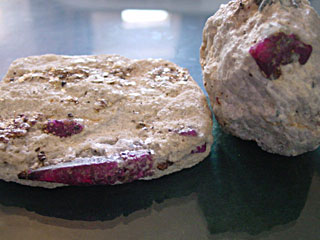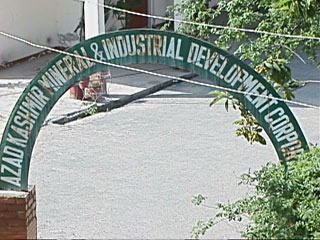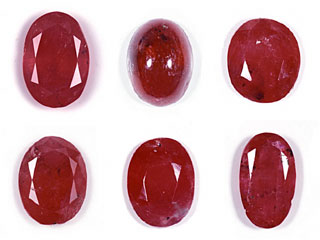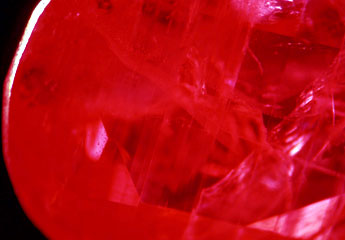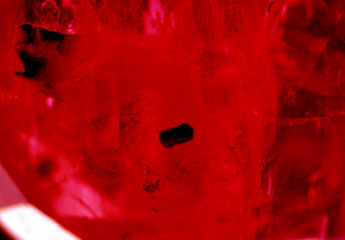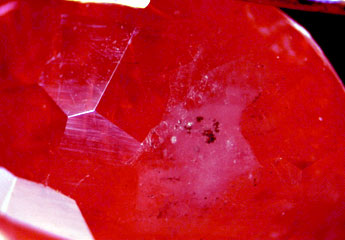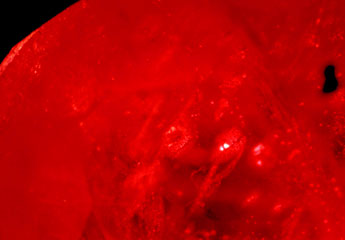|
||||||||||||||||||||||||||||
| We recently examined six pieces of ruby from Kashmir. All of them showed blind-like twinning planes, and unique absorption between 1900cm-1 and 2400cm-1 arose from diaspore was recognised by FTIR analysis. Located in the north west of Indian Continent, Kashmir district has been known as one of the most famous localities of blue sapphire in the world since 1880’s. Fine quality Kashmir sapphires are highly valued in the market, and together with its rarity this material is now traded almost as a legendary gemstone. On the other hand, rubies from this area have been hardly known. Small rough crystals of ruby were found from marble boulder in Nangimali mountains of AZAD district (c.4350m above sea level) in 1979, but its production was low and successive mining was not operated (Photo-1). However, research has been continued by AZAD KASHMIR MINERAL & INDUSTRIAL DEVELOPMENT CORPORATION (AKMDC)(Photo-2) since then and large crystals of fine quality started to be mined recently. Now an auction for domestic market is held once or twice per year.
Samples & Analysis Six pieces of unheated Kashmir rubies were examined. One of them were cabochoned and rest were faceted (Photo-3). Their sizes ranged between 1.5 and 7.5 carats, with the total weight of 19.8ct. Mr. HIRANO of Hirano Trading Co., LTD accommodated the samples to us, and he also supplied us detailed information about the local area. All the samples were examined with standard gemmological identification tests, UV-NIR spectrometry, IR spectrometry, X-ray fluorescence analysis and Raman microspectrometry.
Results ◆ Standard gemmological identification tests Physical properties such as RI and SG lied in the range of common ruby. Stones fluoresced bright red colour under both long and short wavelength of ultraviolet light. All stones showed blind-like twinning planes, some of which were only in one direction along <r> sector (Photo-4) and some in two directions almost at right angles to each other. Twinning planes are commonly seen in rubies from other localities, but the fact that the most highly valued ruby from Mong Hsu in Myanmar in the market hardly shows twinning planes may help to distinguish rubies from these localities. Euhedral rutile (Photo-5), white translucent calcite (Photo-6) and other substances were observed as solid inclusions (those minerals have already been identified by a microscopic Raman spectroscope), and in one piece, splashed-patterned minute inclusion, which is commonly seen in rubies from Mong Hsu, was recognised. Fluid inclusions were seen in all six pieces, one of which showed characteristic plane form (Photo-7) similar to what is often seen in Thai ruby.
◆ UV-Visible spectrometry Shown in Fig. 1 is a UV-Visible spectra chart of a typical ruby from Kashmir. A line between 860 and 700nm was flat with no absorption, which is a characteristic feature of ruby with non-basaltic origin. Transmittance of transmission band in UV region was relatively low compared to that in blue region generally called “blue window”. A peak wavelength of the maximum transmittance in UV region was at 350〜360nm, which was slightly shifted to the longer wavelength than that of general Mong Hsu ruby.
◆ Infrared spectrometry An infrared spectrometry chart of a typical Kashmir ruby is shown in Fig.2. Absorption on 1986cm-1, 2117cm-1, 2335cm-1 and 2349cm-1 were recognised in all six pieces although their intensity varied in each stone. These absorptions are thought to be derived from diaspore (α-AIOOIH). This type of absorptions are often seen in unheated Mong Hsu ruby, but their peak positions are slightly different.
◆ X-ray fluorescence analysis Other than the main components Al2O3, trace elements common to natural ruby were detected. Detected elements were TiO2 and V2O5, each of them measured 200〜300ppm, as well as Cr2O3, Fe2O3 and Ga2O3 with the amount of 2000〜4000ppm, around 100ppm and 100〜150ppm respectively. The combination and amount of these trace elements are common to natural ruby from non-basaltic origin. Summary Six pieces of unheated Kashmir ruby were examined. These materials have marble (crystalline limestone) origin and their marketability can be expected in the future according to the production. All the sample tested showed blind-like twinning planes, and absorption of diaspore was distinctly recognised. These features will help to distinguish Kashmir ruby from ruby of other non-basaltic origin. |
